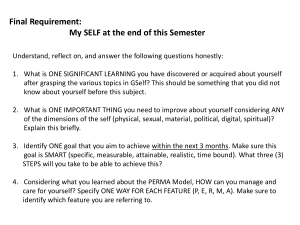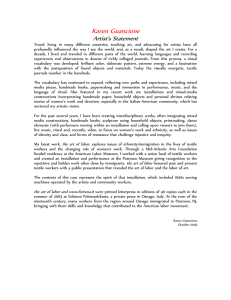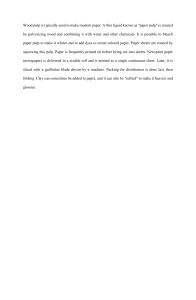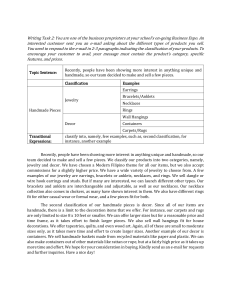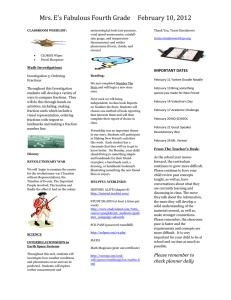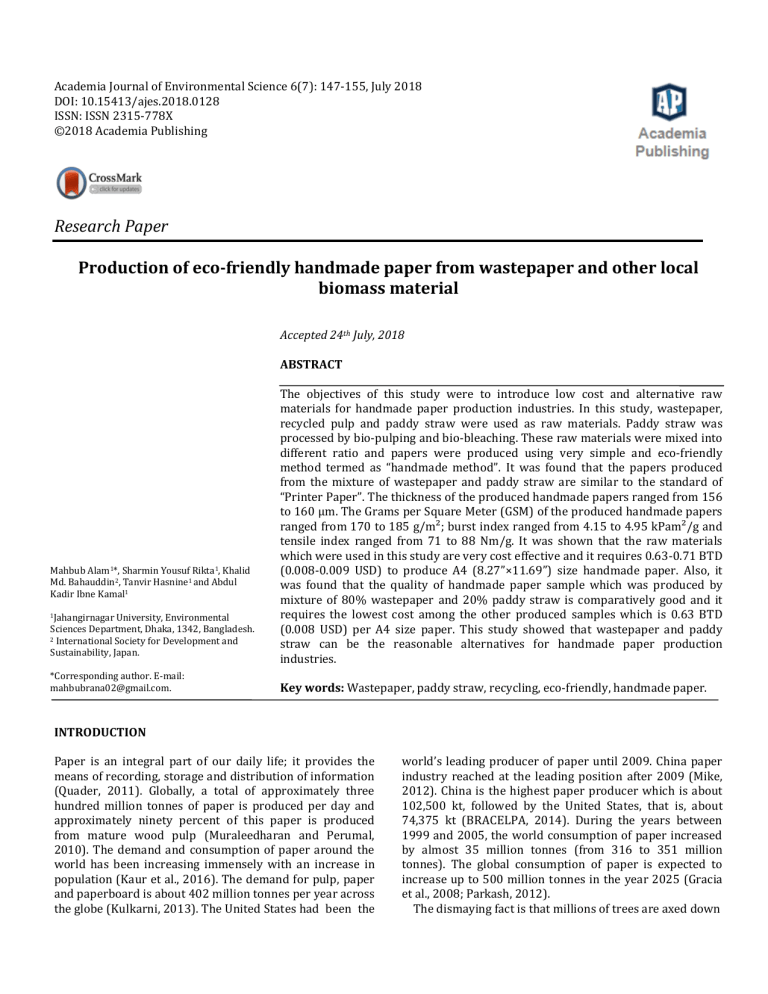
Academia Journal of Environmental Science 6(7): 147-155, July 2018 DOI: 10.15413/ajes.2018.0128 ISSN: ISSN 2315-778X ©2018 Academia Publishing Research Paper Production of eco-friendly handmade paper from wastepaper and other local biomass material Accepted 24th July, 2018 ABSTRACT Mahbub Alam1*, Sharmin Yousuf Rikta1, Khalid Md. Bahauddin2, Tanvir Hasnine1 and Abdul Kadir Ibne Kamal1 1Jahangirnagar University, Environmental Sciences Department, Dhaka, 1342, Bangladesh. 2 International Society for Development and Sustainability, Japan. *Corresponding author. E-mail: mahbubrana02@gmail.com. The objectives of this study were to introduce low cost and alternative raw materials for handmade paper production industries. In this study, wastepaper, recycled pulp and paddy straw were used as raw materials. Paddy straw was processed by bio-pulping and bio-bleaching. These raw materials were mixed into different ratio and papers were produced using very simple and eco-friendly method termed as “handmade method”. It was found that the papers produced from the mixture of wastepaper and paddy straw are similar to the standard of “Printer Paper”. The thickness of the produced handmade papers ranged from 156 to 160 μm. The Grams per Square Meter (GSM) of the produced handmade papers ranged from 170 to 185 g/m²; burst index ranged from 4.15 to 4.95 kPam²/g and tensile index ranged from 71 to 88 Nm/g. It was shown that the raw materials which were used in this study are very cost effective and it requires 0.63-0.71 BTD (0.008-0.009 USD) to produce A4 (8.27”×11.69”) size handmade paper. Also, it was found that the quality of handmade paper sample which was produced by mixture of 80% wastepaper and 20% paddy straw is comparatively good and it requires the lowest cost among the other produced samples which is 0.63 BTD (0.008 USD) per A4 size paper. This study showed that wastepaper and paddy straw can be the reasonable alternatives for handmade paper production industries. Key words: Wastepaper, paddy straw, recycling, eco-friendly, handmade paper. INTRODUCTION Paper is an integral part of our daily life; it provides the means of recording, storage and distribution of information (Quader, 2011). Globally, a total of approximately three hundred million tonnes of paper is produced per day and approximately ninety percent of this paper is produced from mature wood pulp (Muraleedharan and Perumal, 2010). The demand and consumption of paper around the world has been increasing immensely with an increase in population (Kaur et al., 2016). The demand for pulp, paper and paperboard is about 402 million tonnes per year across the globe (Kulkarni, 2013). The United States had been the world’s leading producer of paper until 2009. China paper industry reached at the leading position after 2009 (Mike, 2012). China is the highest paper producer which is about 102,500 kt, followed by the United States, that is, about 74,375 kt (BRACELPA, 2014). During the years between 1999 and 2005, the world consumption of paper increased by almost 35 million tonnes (from 316 to 351 million tonnes). The global consumption of paper is expected to increase up to 500 million tonnes in the year 2025 (Gracia et al., 2008; Parkash, 2012). The dismaying fact is that millions of trees are axed down Academia Journal of Environmental Science; Alam et al. in a day to make paper. The production of 1 metric ton of paper requires 17 trees in an average; 24 trees for white office paper and 12 trees for newsprint (Conservatree, 2015). Paper production is the third most energy-intensive of all manufacturing industries, consuming over 12% of all energy in the industrial sector (Kinsella et al., 2007). According to the Conservatree, the production of 1 metric ton of paper requires around 10,000 kWh of electricity, 25 m3 of water and 2.57 m3 of oil. Handmade Paper is traditionally made by wood free raw materials, such as Silk Cotton, Cotton, Bagasse, Banana fibers, Mat grass, Kenaf and Jute waste; it is also a method to recycle wastepaper (Ideas Afresh Inc., 2016; Muraleedharan and Perumal, 2010). Agro-waste based raw materials have good fiber content and easy pulping capabilities to make quality paper (Jimenez et al., 2008). Recycled wastepaper has being a significant raw material for the handmade paper and paper industries (Pivnenko et al., 2015). Wastepaper recycling also offers substantial environmental benefits in a lifecycle perspective (Laurijssen et al., 2010; Villanueva and Wenzel, 2007). Handmade Paper manufacturing traces its root from China and now it is being practiced by a significant number of countries in Europe and Asia (Ideas Afresh Inc., 2016). Handmade paper is the most eco-friendly form of paper. The main benefit of handmade paper production is a twofold decrease of the environmental loading, known as an environmental impact reducing. From the paramount viewpoint, the natural resources conserve at the side of the manufacturing process inputs, and from the additional viewpoint, the detrimental compounds amount, leaking to the environment drops at the side of the manufacturing process outputs (Cabalova et al., 2011). The handmade paper does turn out a little expensive because it’s not massproduced by machines like mill made paper (Ideas Afresh Inc., 2016). The main objective of this study was to determine the sustainable alternative source of raw materials for the production of handmade paper. The specific objectives are: (i). to assess the suitability of wastepaper recycled pulp and paddy straw for handmade paper making, (ii). to assess the quality of the produced handmade paper and (iii). to develop a low-cost handmade paper. MATERIALS AND METHODS Wastepaper, paddy straw and recycled pulp were selected as raw materials. Wastepaper was purchased from the different municipal waste collection point (Dhaka, Bangladesh). Paddy straw (agro-residue) which is mostly used as fodder was purchased from the Gabtoli Cattle Farm (Dhaka, Bangladesh). Recycled pulp which is mechanically 148 processed and unbleached was purchased from paper recycling factories at Savar, Dhaka. Micro-organisms (Pythium sp., Trichoderma sp. and Pediococcus sp.) were collected from the Department of Microbiology, Jahangirnagar University. Other tools were electronic balance, distilled water and tap water, binding materials (starch/natural glue), hydropulper, blender or beater, deckle or frame, roller, plastic mug, marker pen and paper cutter. Figure 1 shows the hydro-pulper(ML 100L-4) which is used to produce pulp from wastepaper. It can be segmented into digester, input valve, output valve, iron base and 3 HP motor. The digester accommodates wastepaper. Water enters into the digester through input valve and pulp goes out through the output valve. Steps involved in producing handmade paper The “Handmade Method” was adapted from SAMC Research Center, Chennai, India (Muraleedharan and Perumal, 2010) and modified as necessary to produce handmade paper from the selected raw materials. The following steps were involved in producing handmade paper: Wastepaper processing: The wastepaper was being sun dried to remove the moisture. After drying, wastepaper was put into the hydro-pulper and tap water was mixed with the wastepaper as 1:5 ratios. After settling the mixture in the disaster, the hydro-pulper was switched on for 3 min. After 3 min, the output valve was opened and the processed pulp was decanted into a container. Paddy straw processing (bio-pulping and biobleaching): Firstly, the paddy straw was washed by water and then it was sundried. After drying, paddy straw was smashed like powder. Then powder like paddy straw was processed by bio-pulping and bio-bleaching. The fiber of paddy straw generally contains 36% cellulose, 34% hemicelluloses and 12.3% lignin (She et al., 2012). The dull color of the fiber occurs due to the presence of hemicelluloses and lignin (Muraleedharan and Perumal, 2010). Figure 2 shows the processing of paddy straw. In a separate place, this fiber was biologically bleached by microbial treatment. This microbial treatment takes 4-5 days. The micro-organisms called Pythium sp. and Pediococcus sp. or Trichoderma sp. were employed for this purpose. These microbes act on cellulose and breakdown the bonds between the lignocelluloses complex structures. After that, hemicelluloses and lignin are broken down and leached out. The brightness of the paper is augmented due to this process known as bio-bleaching. These microbes act on the fiber and digest the cellulose Academia Journal of Environmental Science; Alam et al. Figure 1: Hydro-pulper(ML 100L-4). Figure 2: Paddy straw processing. 149 Academia Journal of Environmental Science; Alam et al. 150 Table 1: The required amount of raw materials, tap water and binding materials to produce A4 size handmade paper. Samples Whiteprint and color newsprint Sample 1 Sample 2 Sample 3 Sample 4 Sample 5 Sample 6 Sample 7 Sample 8 Sample 9 10 8 - Wastepaper (gm) Whiteprint and newsprint 12 10 - White-print Paddy Straw (gm) Recycled Pulp (gm) Tap water (liter) Binding materials (ml) 10 16 10 7 8 10 6 8 10 10 4 4 7 12 6 6 7 - 1 1 1 1 1 1 1 1 1 25 25 25 25 25 25 25 25 25 along with the bonds arbitrarily and set free of cellulosicfiber clusters from the core lignocelluloses complex. The fiber becomes soft due to this microbial treatment. It makes the pulping process easier. After the microbial treatment, it was need to wash the fiber by distilled water to confiscate surplus materials and microbial strains. manufacturing process where the paper passes between polished metal rolls. This increases the surface smoothness of paper and provides a uniform thickness (Micro Format Inc., 2014). Figure 3 shows the samples of produced handmade paper. Mixture of raw materials and addition of binding materials: The processed wastepaper, paddy straw and recycled pulps were mixed into different ratios for obtaining the desired quality paper. Binding materials (that is, starch or natural glue) were added to improve the binding strength among the mixed pulp. Table 1 shows the required amount of raw materials, tap water and binding materials to produce A4 size handmade paper. After mixing the raw materials in different ratio and adding binding materials, the mixture was blended by a blender for 5 min. Afterward, the pulp was ready for paper making. Physical test analysis of handmade paper Evenly spreading pulp on deckle or frame and Rolling: The pulp was uniformly spread on the Deckle or Frame. It is one of the important steps for handmade paper making. The pulp should be spread very carefully on the frame to maintain the uniform thickness of the paper. After spreading the pulp on the frame, a roller was used for rolling them. Rolling makes the surface little smoother and makes a shape of paper. Sun drying: As soon as the pulp settled to the frame, the water was drained out from the pulp, and then the frame was kept for drying process. The frame was settled down for six to eight hours in a suitable place for full sun drying. When the paper was completely dried, it was gently peeled off from the frame. Calendaring: This step was involved in calendaring of paper. Calendaring is an important part of the paper Burst index is the quotient of the bursting strength of a paper and its grammage in the conditioned state as defined in the standard method of test (British standard BS 3137, BS 2922:1 and International standard ISO 2758 and ISO 2759). Burst index (kPa.m²/g) = burst strength/basis weight (Alam et al., 2016). Tensile index is the tensile strength of the paper and is measured by applying a tensile force parallel to the plane of the paper and great enough to induce failure or rupture. The unit of tensile index is Nm/g (TAPPI, 1988). The thickness or "calliper" of paper, board and tissue can be measured on a single ply or multiple plies using a dead weight micrometer and expressed in μm or "microns" (Alam et al., 2016). GSM (Grams per Square Meter) is used in the measurement of the quality of paper. Normal office paper would be 80 g/m², the good quality paper would be 100 to 120 g/sm² and paperboard would be 250 g/m² plus(Mera Calculator, 2011). RESULTS AND DISCUSSION Physical tests of produced handmade paper are performed to govern the quality of handmade paper. Table 2 shows the physical test results of nine different samples of produced handmade paper and the comparison with the standard of paper. Academia Journal of Environmental Science; Alam et al. Sample 1 (WPwc = 50%, PS = 50%) Sample 4 (WPwn = 50%, PS = 50%) Sample 7 (WPw = 50%, RP= 30%, PS = 20%) 151 Sample 2 (WPwc = 40%, RP= 30%, PS = 30%) Sample 3 (WPwn = 60%, PS = 40%) Sample 5 (WPw = 50%, PS = 50%) Sample 6 (WPw = 80%, PS = 20%) Sample 8 (WPw = 33.3%, RP= 33.3%, PS = 33.3%) Sample 9 (WPw = 40%, PS = 60%) Figure 3: Samples of produced handmade paper. WPwc = Wastepaper (Whiteprint and color newsprint), WPwn = Wastepaper (Whiteprint and newsprint), WPw = Wastepaper (Whiteprint), PS = Paddy Straw, RP =Recycled pulp. According to the physical test analysis result of produced handmade paper, the average thickness of samples 2, 7 and 8 were 308, 318 and 320 μm respectively. The average GSM of these samples were 250, 252 and 255 g/m² respectively. The average thickness and GSM of these three samples are similar to the standard of “Paperboard”. However, their average burst index and tensile index are not in the range of “Paperboard” standard. The average burst index of samples 2, 7 and 8 were 3.30, 3.52 and 3.80 kPam²/g, respectively. The average tensile index of these three samples were 69, 74 and 80 Nm/g, respectively. Therefore, samples 2, 7 and 8 were not worthwhile on the basis of their quality test Academia Journal of Environmental Science; Alam et al. 152 Table 2: Physical test results (mean ± standard deviation) of produced handmade paper. Burst Index (kPam²/g) Tensile Index (Nm/g) 105-110 150-300 300 plus GSM (g/m²) 80-120 120-200 250 plus 2.5-3.9 4.0-6.0 6.0 plus 40-70 70-150 150 plus (Paperonweb, 2014) Sample 1 156±0.13 170±0.07 4.15±0.01 71±0.11 Sample 1 is similar to the standard of “printer paper” Sample 2 308±0.16 250±0.11 3.3±0.04 69±0.11 Sample 2 is not similar to the standard paper (not viable) Sample 3 157±0.38 174±0.21 4.35±0.25 78±0.21 Sample 3 is similar to the standard of “printer paper” Sample 4 156±0.79 170±0.79 4.18±0.13 72±0.35 Sample 4 is similar to the standard of “printer paper” Sample 5 158±0.16 180±0.07 4.82±0.02 86±0.11 Sample 5 is similar to the standard of “printer paper” Sample 6 160±0.79 185±0.32 4.95±0.04 88±0.38 Sample 6 is similar to the standard of “printer paper” Sample 7 318±0.16 252±0.07 3.52±0.02 74.2±0.37 Sample 7 is not similar to the standard paper (not viable) Sample 8 320±0.79 255±0.79 3.8±0.04 80±0.35 Sample 8 is not similar to the standard paper (not viable) Sample 9 158±0.16 175±0.07 4.476±0.02 78±0.11 Sample 9 is similar to the standard of “printer paper” Samples/Standards Standards of Paper Office paper Printer paper Paper-board Thickness (μm) analysis. On the other hand, the average thickness of samples 1, 3, 4, 5, 6 and 9 were 156, 157,156, 158, 160 and 158 μm, respectively. The average GSM of these sample papers were 170, 174, 170, 180, 185 and 175 g/m², respectively. The average thickness and GSM of these six samples are similar to the thickness and GSM of “Printer Paper”. Their average burst index and tensile index are also in the range of “Printer paper” standard. The average burst index of samples 1, 3, 4, 5, 6 and 9 were 4.15, 4.35, 4.18, 4.82, 4.95 and 4.48 kPam²/g, respectively. The average tensile index of these six samples were 71, 78, 72, 86, 88 and 78 Nm/g, respectively. Therefore, these samples satisfy the standard of “Printer Paper”. Among all the samples, the quality of sample paper 5 and sample paper 6 were particularly good. Figures 4 and Remarks 5 shows that the quality of sample paper 6 was better than the sample 5. COST ESTIMATION OF PRODUCED HANDMADE PAPERS Cost estimation is one of the crucial parts of any development study or projects that aid to determine the viability of the idea (Theuri, 2014). In this study, laboratory scale production cost has been estimated. Table 3 shows the cost of raw materials and other logistics. All cost is documented in Bangladeshi Currency (BDT). Figure 6 shows the production cost of handmade papers. It shows that sample 8 was the most expensive sample which costs 0.71 BDT per A4 size paper, followed by the sample 9, that is, 0.68 BDT. Samples 2, 5 and 7 required the Academia Journal of Environmental Science; Alam et al. 153 Figure 4: Burst index vs. Samples of produced handmade paper. WPwc = Wastepaper (Whiteprint and color newsprint), WPwn = Wastepaper (Whiteprint and newsprint), WPw = Wastepaper (Whiteprint), PS = Paddy Straw, RP =Recycled pulp. Figure 5: Tensile index vs. Samples of produced handmade paper. WPwc = Wastepaper (Whiteprint and color newsprint), WPwn = Wastepaper (Whiteprint and newsprint), WPw = Wastepaper (Whiteprint), PS = Paddy Straw, RP =Recycled pulp. Academia Journal of Environmental Science; Alam et al. 154 Table 3: The cost of raw materials and other logistics. Items Wastepaper (whiteprint and color newsprint) Wastepaper (whiteprint and newsprint) Wastepaper (whiteprint) Recycled pulp Paddy straw Binding materials (starch) Energy consumption bill Cost (BDT) /kg 10 12 14 20 20 5 0.2 Per A4 (8.27”×11.69”) size paper Figure 6: The production cost of the produced A4 size handmade papers. WPwc = Wastepaper (Whiteprint and color newsprint), WPwn = Wastepaper (Whiteprint and newsprint), WPw = Wastepaper (Whiteprint), PS = Paddy Straw, RP =Recycled pulp. [1 USD = 78 BDT]. same cost which was 0.67 BDT per A4 size paper. Sample 4 costs 0.65 BDT, while samples 1, 3 and 6 were the cheapest which costs 0.63 BDT per A4 size paper. CONCLUSIONS The World is struggling with its pulp and paper industries due to the shortage of forest and trees. It is time to look for alternatives to overcome this situation. In this study, “Handmade Method” was adopted to produce paper from alternative raw materials. Introducing low cost alternative raw materials for handmade paper production was the prime concern of this research. At this point, wastepaper, recycled pulp and paddy straw were selected as alternative raw materials. It was found from the physical test results that the papers which were produced from the mixture of recycled pulp, wastepaper and paddy straw were not worthwhile. However, the papers which were produced from the mixture of wastepaper and paddy straw are similar to the standard of “Printer Paper”. On the basis of physical test analysis and cost estimation, it can be said that sample paper 6 which is produced by 80% whiteprint wastepaper and 20% paddy straw is particularly good Academia Journal of Environmental Science; Alam et al. among all other samples. Finally, it can be understood that wastepaper and paddy straw are very cost effective and can be the reasonable alternative raw materials for handmade paper industries. This study can contribute to the global environment and national economy by producing the ecofriendly handmade papers and various paper products. ACKNOWLEDGMENT The authors are grateful to the authority of Pulp and Paper division, Bangladesh Council of Scientific and Industrial Research (BCSIR) for the laboratory support and the analysis of the physical parameters of the produced handmade papers REFERENCES Alam M, Sharmin YR, Hasnine MT, Ahmed F, Kamal AKI (2016). Production of Eco-friendly Handmade Paper from The Waste Paper Generated in Municipalities of Dhaka City, Bangladesh. EurAsia Waste Management Symposium, 2-4 May 2016, YTU 2010 Congress Center, Istanbul/Turkey. BRACELPA (2014). Brazilian Pulp and Paper Industry, Brazil. Cabalova I, Kacik F, Geffert A, Kacikova D (2011). The Effects of Paper Recycling and its Environmental Impact. Environmental Management in Practice. Dr. Elzbieta Broniewicz (Ed.), InTech, DOI: 10.5772/23110. Conservatree (2015). Trees into Paper. http://conservatree.org/learn/EnviroIssues/TreeStats.shtml (Accessed 22.06.2016). Gracia MM, Lopez F, Alfaro A, Ariza J, Tapias R (2008). The use of Tagasaste (Chamaecytisus proliferus) from different origins for biomass and paper production. Bioresour. Technol. 99(9): 3451-3457. Ideas Afresh Inc. (2016). About Handmade Paper. http://www.handmadepaper-products.com/about-handmadepaper.html(Accessed 01.11.2016). Jimenez L, Rodriguez A, Perez A, Moral A, Serrano L (2008). Alternative raw materials and pulping process using clean technologies. Ind. Crops Prod. 28(1): 11-16. Kaur D, Bhardwaj NK, Lohchab RK (2016). Prospects of rice straw as a raw material for paper making. Waste Manag. 60:127-139. 155 Kinsella S, Gleason G, Mills V, Rycroft N, Ford J, Sheehan K, Martin J(2007). The State of the Paper Industry-Monitoring the Indicators of Environmental Performance. A collaborative report by the Steering Committee of the Environmental Paper Network. Kulkarni HD (2013). Pulp and paper industry raw material scenario-ITC plantation a case study. Ippta J. 25(1): 79-82. Laurijssen J, Marsidi M, Westenbroek A, Worrell E, Faaij A (2010). Paper and biomass for energy? Resour. Conserv. Recycl. 54(12): 1208-1218. Mera Calculator (2011). GSM of Paper. http://www.meracalculator.com/physics/classical/papercalculator.php(Accessed 11.07.2016). Micro Format Inc. (2014). Eliminate the confusion – Paper weight and size. Retrieved from, http://www.paper-paper.com/weight.html (Accessed 20.06.2016). Mike DS (2012). China’s Paper Operation. Pulitzer Center on Crisis Reporting (Accessed 30.10.2016). Muraleedharan H, Perumal K (2010). Booklet on ecofriendly handmade paper making. SAMCRC, Taramani, Chennai-600113. Paperonweb (2014). Properties of paper. http://www.paperonweb.com/paperpro.htm(Accessed 22.10.2014). Parkash D (2012). Reduction of toxicity by using chlorine dioxide in paper making. J. Sci. 1(2): 30-35. Pivnenko K, Eriksson E, Astrup TF (2015). Waste paper for recycling: Overview and identification of potentially critical substances. Waste Managementhttp://dx.doi.org/10.1016/j.wasman.2015.02.028. She D, Nie XN, XU F, Geng ZC, Jia HT, Jones GL, Baird MS (2012). Physicochemical Characterization of Different Alcohol-Soluble Lignins from Rice Straw. Cellulose Chem. Technol. 46(3-4): 207-219. TAPPI (1988). TAPPI proceedings of the 1988 paper preservation symposium. TAPPI Press. pp. 31-40. Theuri B (2014). Project Planning and Feasibility Study. Slide Share. https://www.slideshare.net/marsmfyam/project-planning-andfeasibility-study Villanueva A, Wenzel H (2007). Paper waste – recycling, incineration or landfilling? A review of existing life cycle assessments. Waste Manag. 27(8): S29-S46. Cite this article as: Alam M, Rikta SY, Bahauddin K, Hasnine T, Kamal AKI (2018). Production of eco-friendly handmade paper from wastepaper and other local biomass material. Acad. J. Environ. Sci. 6(7): 147-155. Submit your manuscript at: http://www.academiapublishing.org/ajes
